

Audrey Lau
A content writer from aboveA. Passionate about blending creativity with data-driven insights to craft accessible, resonant content for diverse audiences.
How Do You Create a Winning Business Plan and Pitch Deck in 2025?
Want to get your young business started on the right foot? Having a solid business plan and a winning pitch deck is the easiest way to guarantee that. It’s a difficult task to make your start-up stand out from the crowd, but knowing your basics about how to get investors hooked will be a massive help.
Pitch decks and business plans are used for different stages in the incubation of any start-up. This article will tell you how to succeed with both and make the most of your business strategy.
Need any help on getting your startup up and running?
Table of Contents
Business Plan vs Pitch Deck: Key Differences and When to Use Each
A business plan and pitch deck serve different, but equally important, purposes in your startup’s journey. While a business plan is your full roadmap. A pitch deck is your hook. One dives deep into the inner workings of your business, and the other sparks interest in minutes. You don’t need to choose one over the other. You just need to know when to use which. Here are a couple of quick key differences between a business plan and a pitch deck, as well as when to use which one:
Audience:
- A business plan can be used for internal planning or for future reference for interested investors.
- A pitch deck can be used to attract potential investors into learning more about your business or as a visual aid for a live presentation.
Format:
- A business plan should have all of its contents on a detailed, written document.
- A pitch deck should come in the form of a multiple-slide presentation.
Content:
- A business plan goes into more depth about the technical, financial, and logistical specifications of your business idea.
- A pitch deck is a concise but informative overview of your startup.
How to Write a Business Plan That Gets Results
A solid business plan is more than just a document; it’s a roadmap for growth and a tool to attract investors, partners, or stakeholders. Below are the essential sections every effective business plan should include:
Executive summary
An executive summary is a short overview or introduction at the beginning of your business plan that summarizes key points. You can outline the main objectives of your business, such as your chosen niche or sector, how you want it to eventually grow, and so on.
Product/service breakdown
Your product or service breakdown will describe what you are selling to consumers and why you stand out from other competing businesses. The specific features or components of your product will be developed in this section.
Market research
Including any market research you’ve done will help you to collate your analyses of your competition and the surrounding industry. The sales strategy you employ can be supported by your knowledge of the market you are trying to break into. Your claims can all be substantiated by current and updated statistics.
Marketing & sales strategy
Define how you are planning on selling your product to consumers. Outlining your target consumer demographic and sales platforms will make your sales strategy clearer. Information on your planned promotional strategy would be helpful to further visualise your company ethos. This section will allow you to go into further detail about your unique sales proposition, also known as your USP, and how this will be conveyed through your marketing strategy.
Operations plan
To foster company growth, you will need a concrete operations plan. This will include information on job roles, company structure, and how day-to-day processes will be carried out. The following information must be included:
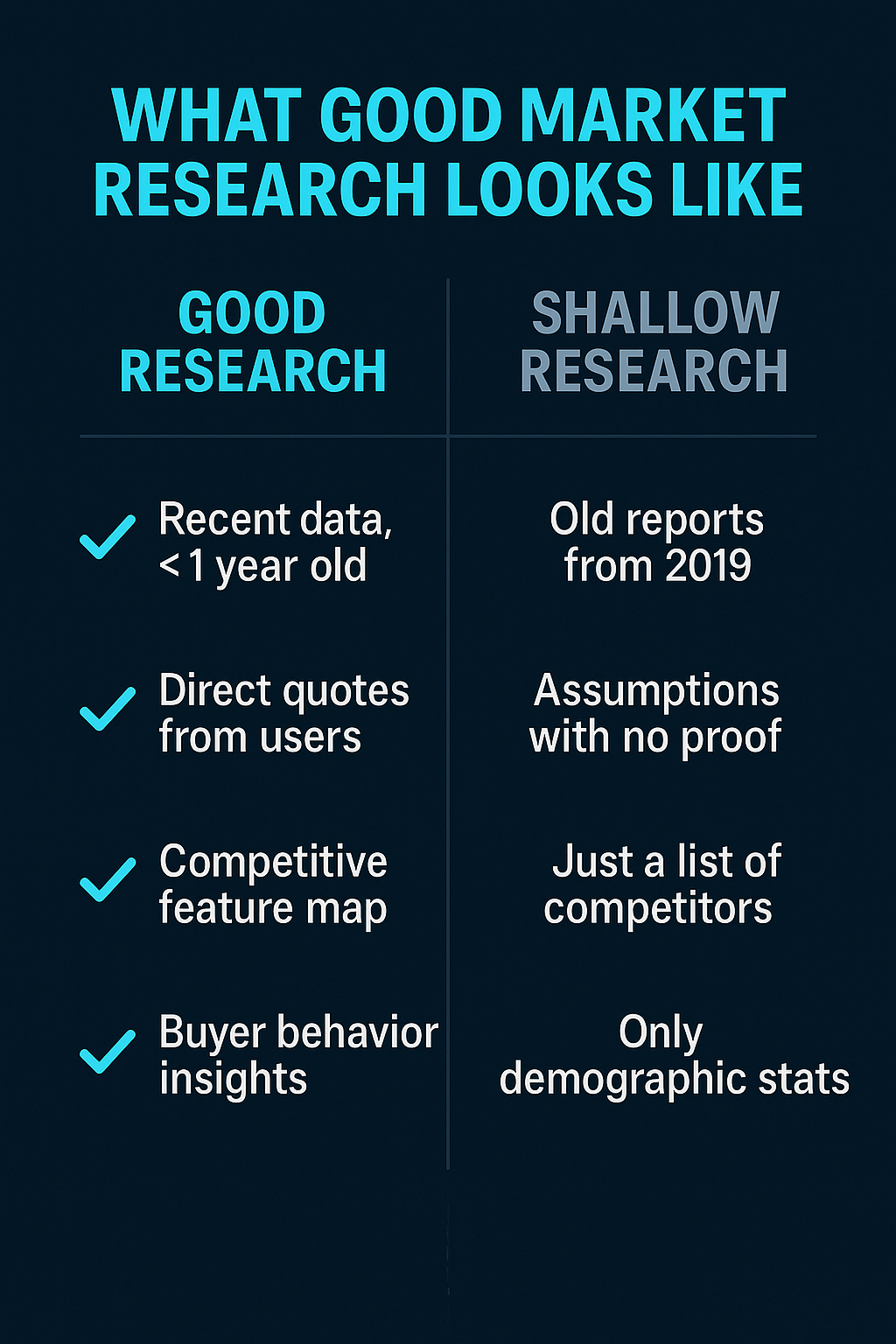
- Location base of your business – will you have a physical office space or building?
- Production – how are you planning on producing your products? Will you be planning on outsourcing anything?
- Suppliers – who will be your suppliers, and do you have confirmed contracts?
- Employees – how will you be managing your employees and company hierarchy?
- Distribution – what is your plan for distributing your product to consumers?
This section of your business plan is usually the most detailed.
Financial plan
Your financial plan will create a detailed view of how your startup plans to achieve profitability. Financial KPIs like your projected revenue growth, any anticipated expenses, and any existing capital should be included here. A 3 to 5-year financial forecast will be needed as well to further demonstrate your startup’s profitability. Charts, graphs, and other visuals will help to illustrate your financial forecasts. You should also include the following:
- A balance sheet.
- A cash flow statement.
- Any other relevant financial information.
- Any information on your startup’s requests for funding.
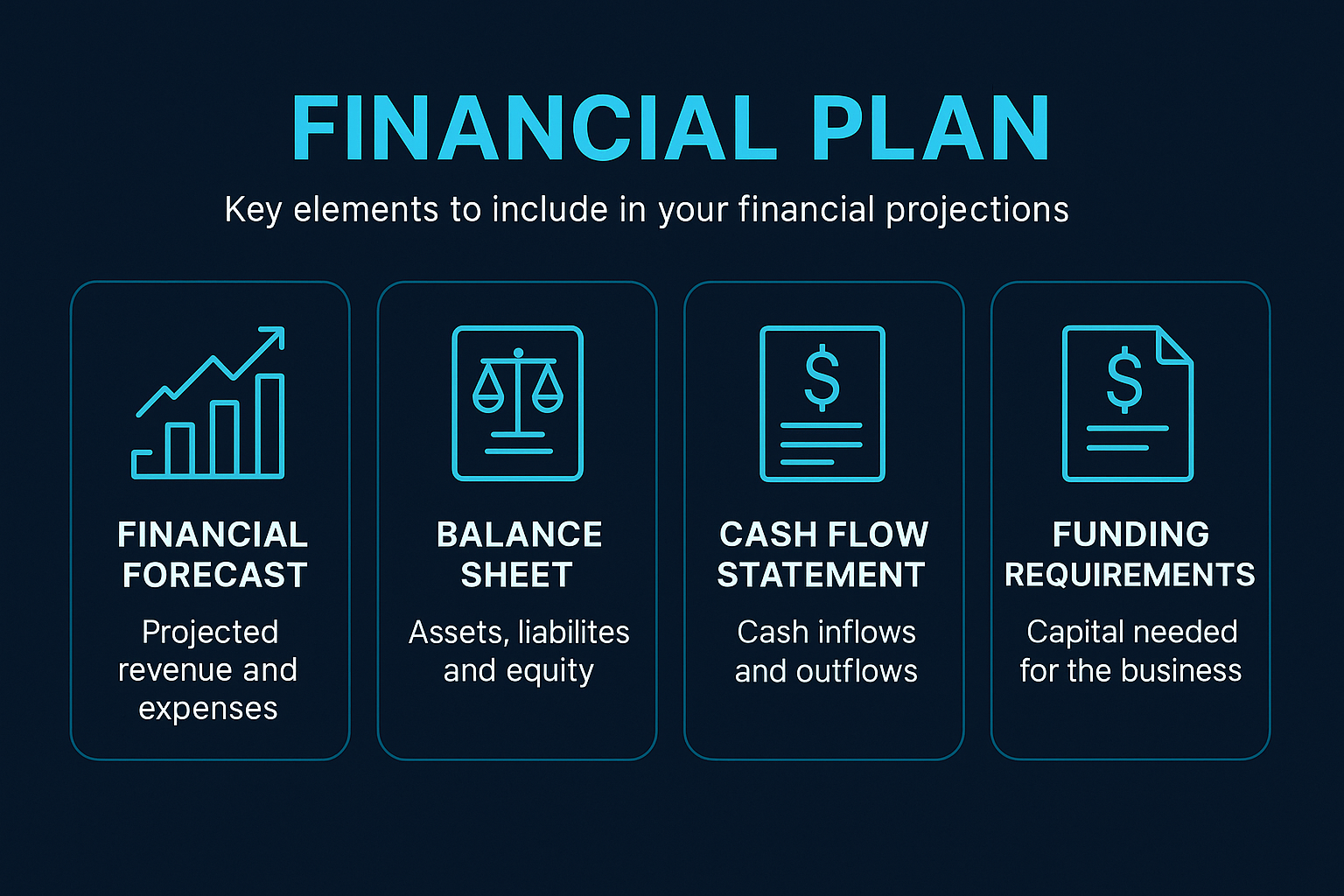
Appendices
These would be supporting documents that can add further detail to what’s in your business plan. This can include any of the following:
- Legal documents.
- Potential marketing materials.
- Licenses, patents, or trademarks.
- Resumes of your core management team.
- Contracts with clients or vendors.
- Anything else that you deem helpful for additional support.
What to Include in a Winning Startup Pitch Deck
A pitch deck is your startup’s first impression. Often, your only chance to win investor interest. It should tell a clear, compelling story of the problem, your solution, and why your team is the one to bet on. Below are the key sections every successful pitch deck should include:
The Problem
Define the need that exists in the market for your proposed product or service. It should be as concise as possible and highly specific.
Our Solution
Explain how your product or service solves the problem in the market and why your business is the best option. The inclusion of other supporting materials like a “how-to” video, demonstration, or other footage would be good to have at this point in your presentation.
Market Opportunity
You need to prove to investors that this is a financially viable opportunity so you can guarantee their support. To do this, you need to determine your target market with information about your ideal customer. This could include any demographic information or buying behaviour that would be helpful to know.
Traction & Proof
This section of your presentation needs to be about any growth your company has seen so far. You can highlight Key Performance Indicators (KPIs), like growth rate, retention rate or any other early wins. The intent is to build credibility for your start-up, and the best way to do it is by providing supporting data.

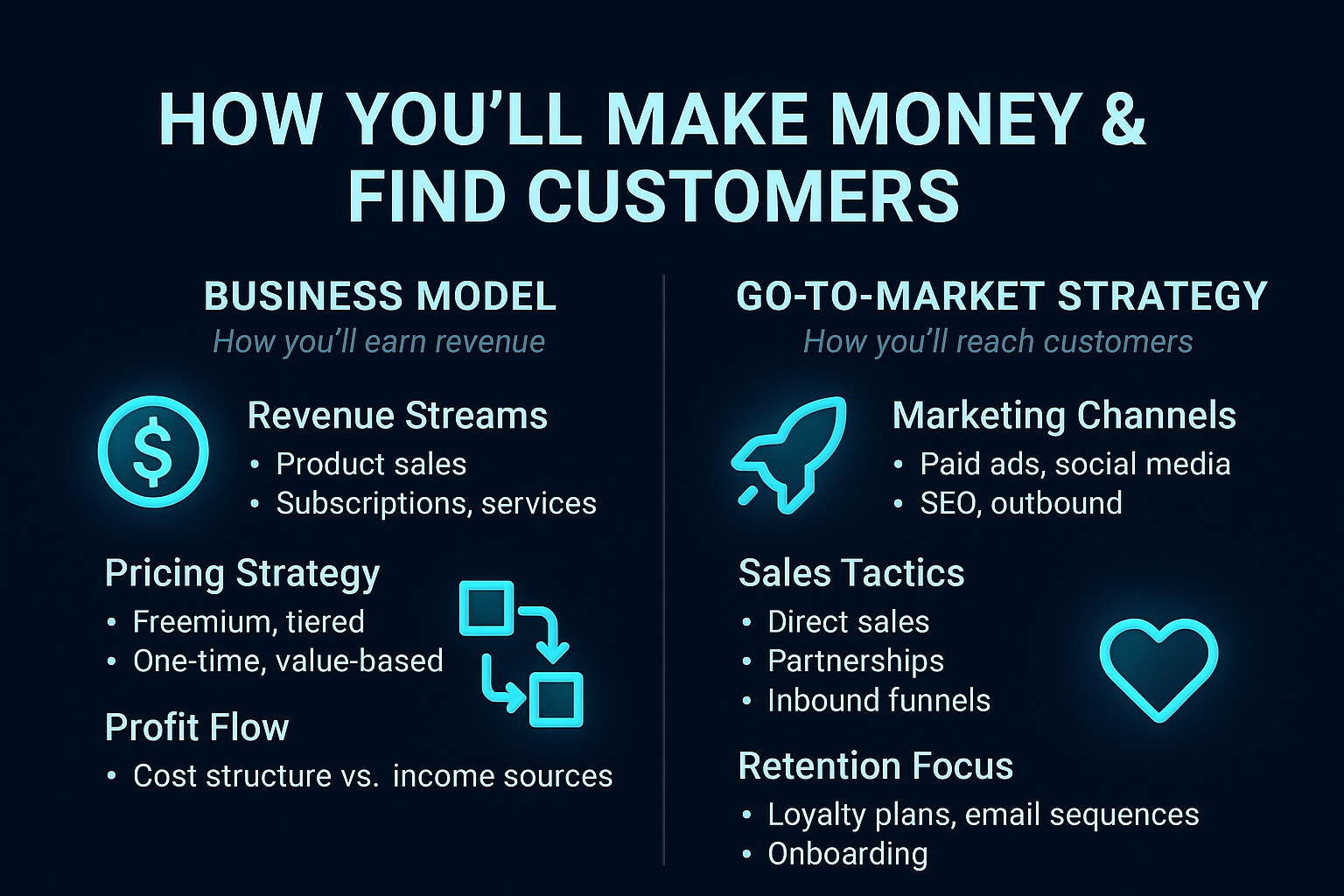
Business Model
To put it simply, you need to describe how your business is planning on making money. Important information to include would be your pricing strategy and planned revenue streams. You can leverage visuals like flowcharts to further support your business model.
Go-to-Market Strategy
How are you planning on acquiring customers? This big question can be answered by you explaining your overall marketing strategy. Any potential marketing channels, such as paid advertisements, social media presence, or direct sales, should be described in detail. You should demonstrate a solid foundation of knowledge on how to win over and retain your customers.
Financials & Funding Ask
Investors want to know all of your financial information, which is crucial to gain their trust and prove why your company is worth investing in. You will need to show at least a three-year projection of your potential sales, major expenses, and income statement. You don’t need any in-depth spreadsheets, but any basic charts should be included in your presentation.
Bad vs Good Pitch Deck: Real Examples That Convert
Your pitch deck can either win investor interest or lose it in the first few seconds. To help you avoid the most common pitfalls, here are real-world examples of both bad and good slides from some of the world’s most recognized startups.
Bad example: Overly wordy introductory slide
Foursquare is currently a highly successful locational data company for enterprises. It was formerly a social networking app, where users could search for locations and leave reviews or comments. However, the introduction to their first pitch deck, first delivered to investors in 2009, looked like this:
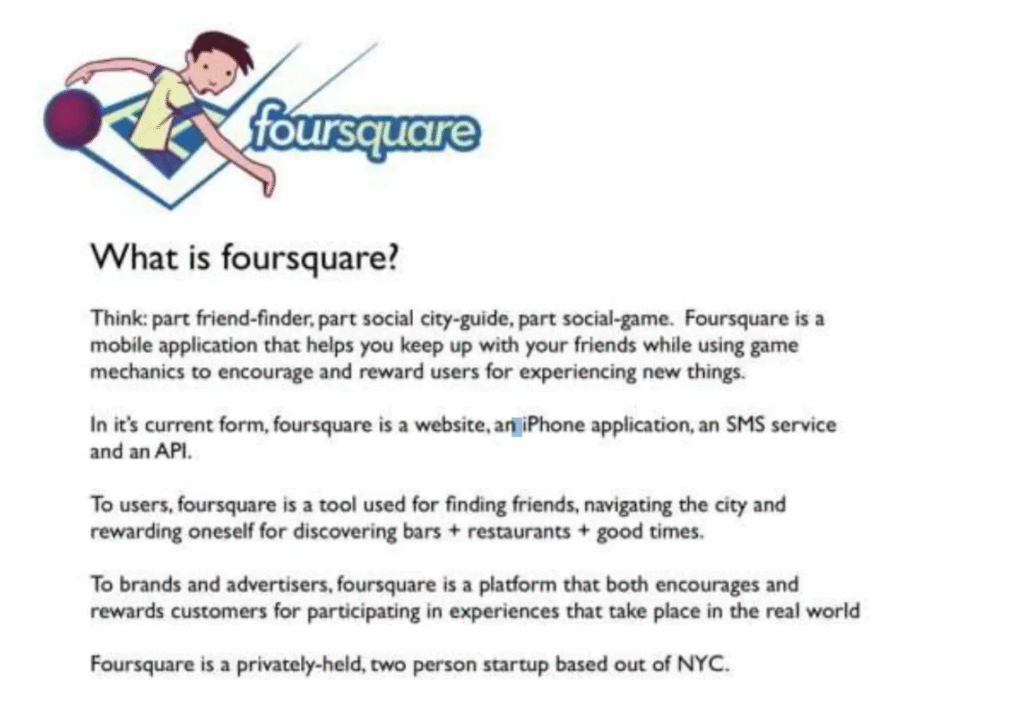
Image Source: FOURSQUARE pitch deck
The opening slide contains a huge chunk of text, which would be difficult for investors to follow. The full sentences are unnecessary and could have been summarised into simpler bullet points. The font can also be increased in size if there is less text on the slide.
Good example: A clear and concise introductory slide
Airbnb is the most popular vacation home rental platform on the market right now. Their 2009 pitch deck was incredibly successful and easy to understand.
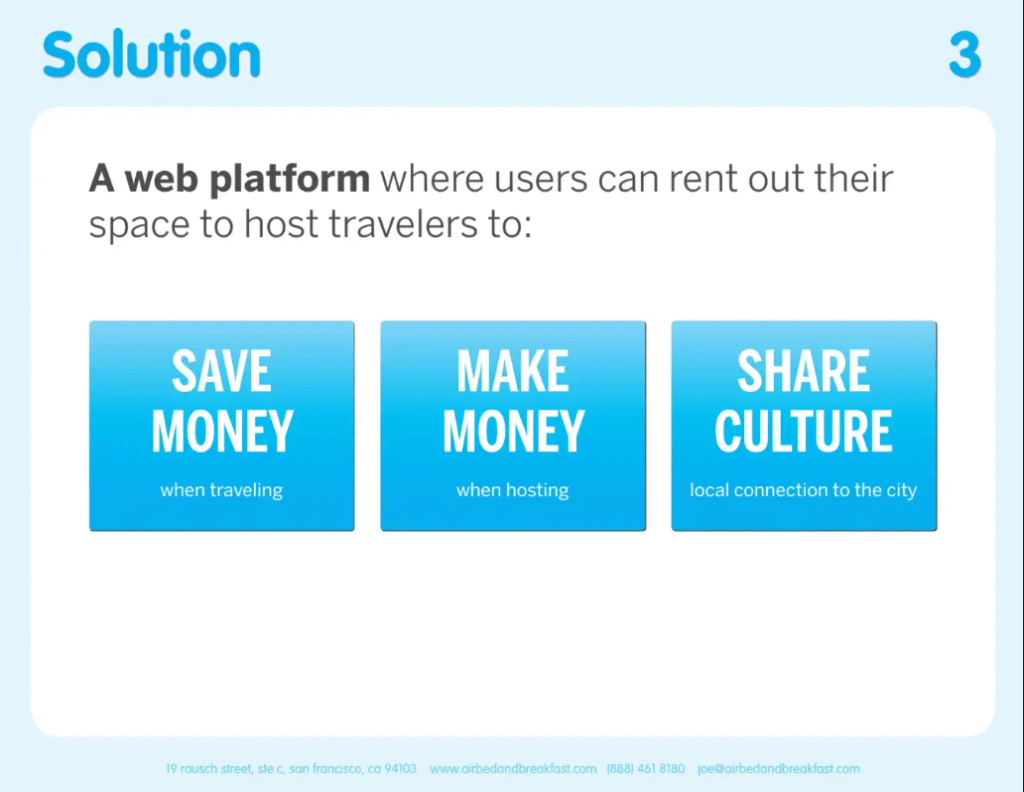
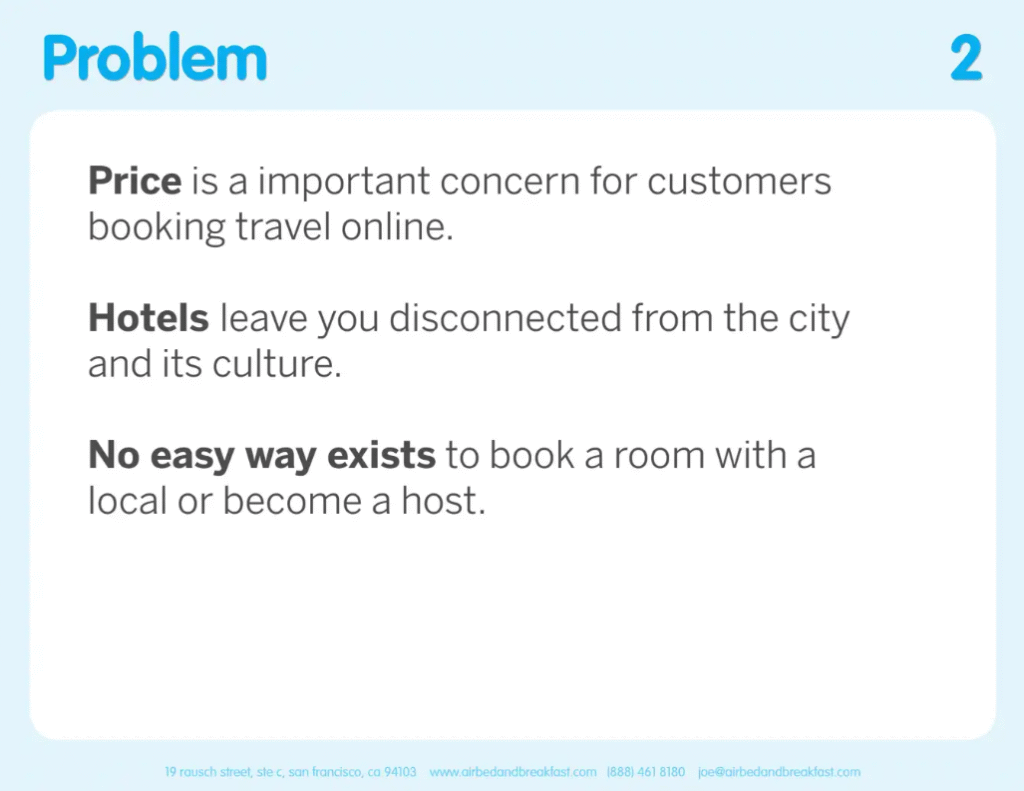
Image Source: Airbnb pitch deck
As you can see above, they outlined the market need for their service with a clear problem-solution structure in their introduction. In the first two slides, they’re already able to describe the problems that both travellers and locals face, as well as their three-pronged approach to solving these issues.
Bad example: Unclear metrics
In YouTube’s pitch deck from 2006, as you can see below, their metrics slide was unclear and too simple.
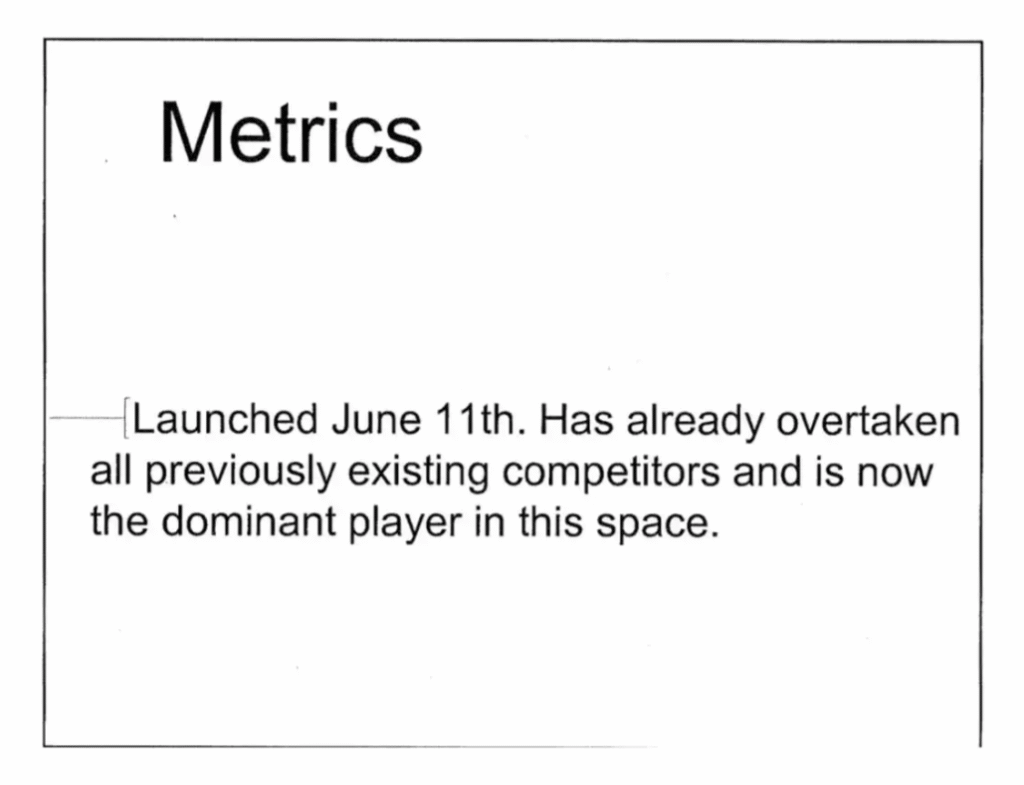
Image Source: YouTube Pitch Deck
They only have one statement on their metrics slide, and the vocabulary is extremely vague. Some statistics or factual proof of their ‘overtaking all previously existing competitors’ would be a good addition at this point.
Good example: Well-defined and concrete numbers
Shopify is an e-commerce platform for entrepreneurs, retailers, major brands, and customers that streamlines the online buying process. Their section on financial metrics in their 2016 pitch deck was considerably comprehensive.
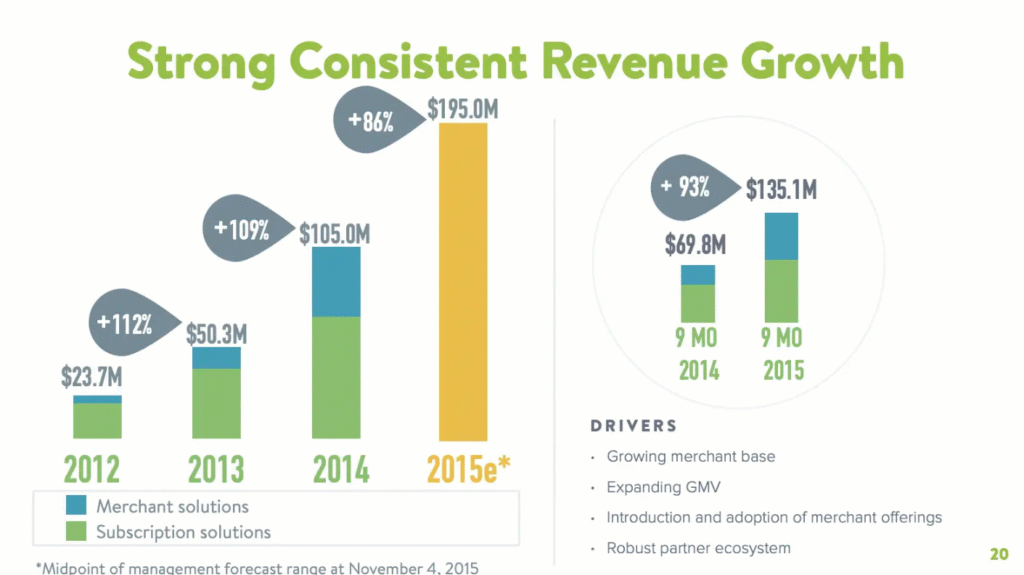
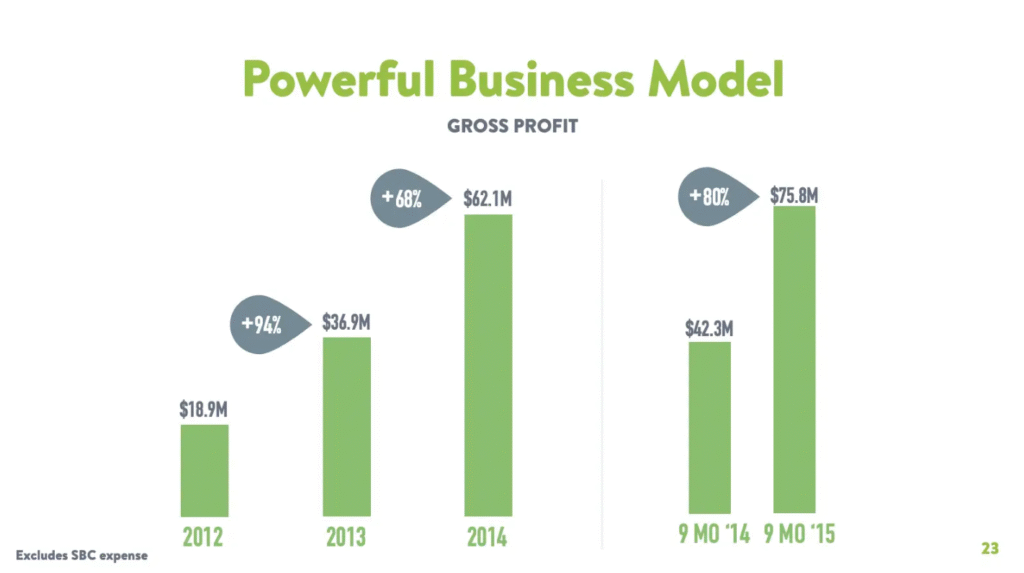
Image Source: Shopify pitch deck
In the slides shown above and in the rest of the section, they’ve used a variety of charts and graphics to show visual proof of how their company will have consistent growth. They walk investors through all of the data they’ve gathered on the success of their company.
Bad example: Confusing information about your team
Rokoko is a company that manufactures motion-capture technology for digital creators. However, though the rest of their original 2022 pitch deck is strong, there could have been some improvements made to their team slide.
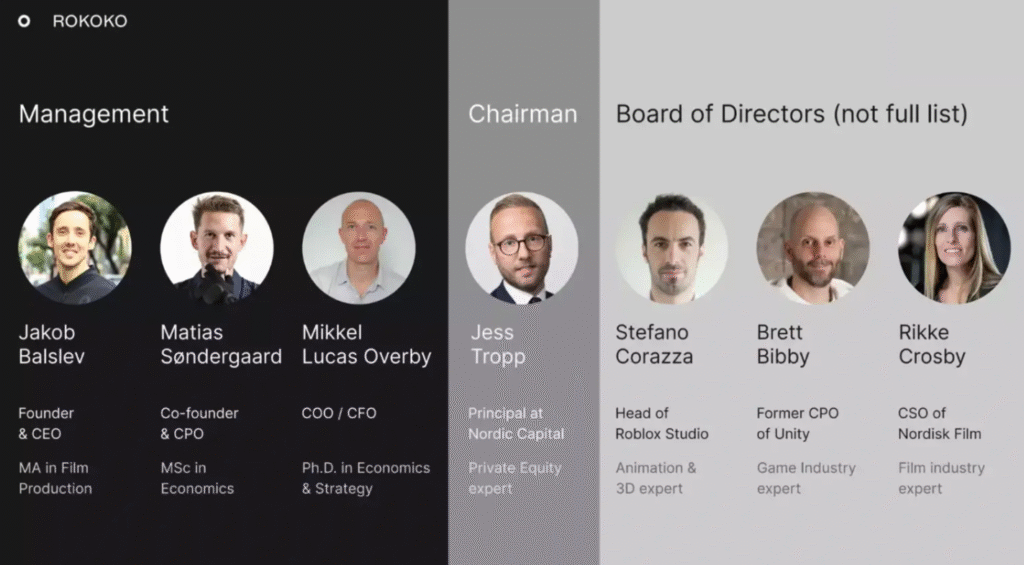
Image Source: Rokoko pitch deck
The list of names and faces seems impressive, but there’s a severe lack in information about some of the team’s actual experience besides academic credits. Instead, it might be more beneficial to pare down the list of people, but go into further detail about the specific benefits of each team member and what skills they’ll bring to the table.
Good example: Proving why your team is ideal
7bridges designs software for supply chain management by consolidating data onto one platform. Their team slide on their 2020 pitch deck is concise yet informative.

Image Source: 7bridges pitch deck
In this team slide, they’ve just focused on their core management team, but they’ve gone beyond adding basic details. For each member, they’ve also included information on industry-specific experience and personal achievements that will add to the effectiveness of their team.
Investor Pitch Deck Checklist: What VCs Look for in 2025
Venture capitalists review hundreds of pitch decks – often in under 4 minutes per deck. If you want yours to stand out, it needs to hit the right notes fast. Here’s a simple checklist of what top investors are actively looking for in 2025:
1. A clear problem-solution narrative
How does your product or service provide a solution to an existing problem? Your startup needs to be positioned as the ideal choice for anyone who wants to solve said problem. Then, you need to prove that there’s a specific growing need for your startup. Providing evidence of trends that will favour your startup will be helpful, such as statistics or cited information from credible sources.
2. A well-defined business model
You need to be clear about your revenue model and how exactly the operations of your startup will be run. Investors want to see that you have a detailed plan for the day-to-day functions of your company and that this plan will guarantee an upward trajectory.
3. A profitable market strategy
Clear channels for advertising and customer acquisition will show your investors the potential for your startup’s success in the market. Strategies adapted for your target audience will help you get even more specific and show that you understand what your consumers want to see.
4. A fair financial projection
Being honest and realistic about your financial projection, as well as your use of funds, is extremely important. It can be easy to resort to inflating numbers and make seemingly confident assumptions, but complete clarity is necessary. Financial milestones should be logical, and your financial projection should be for the next 3-5 years.
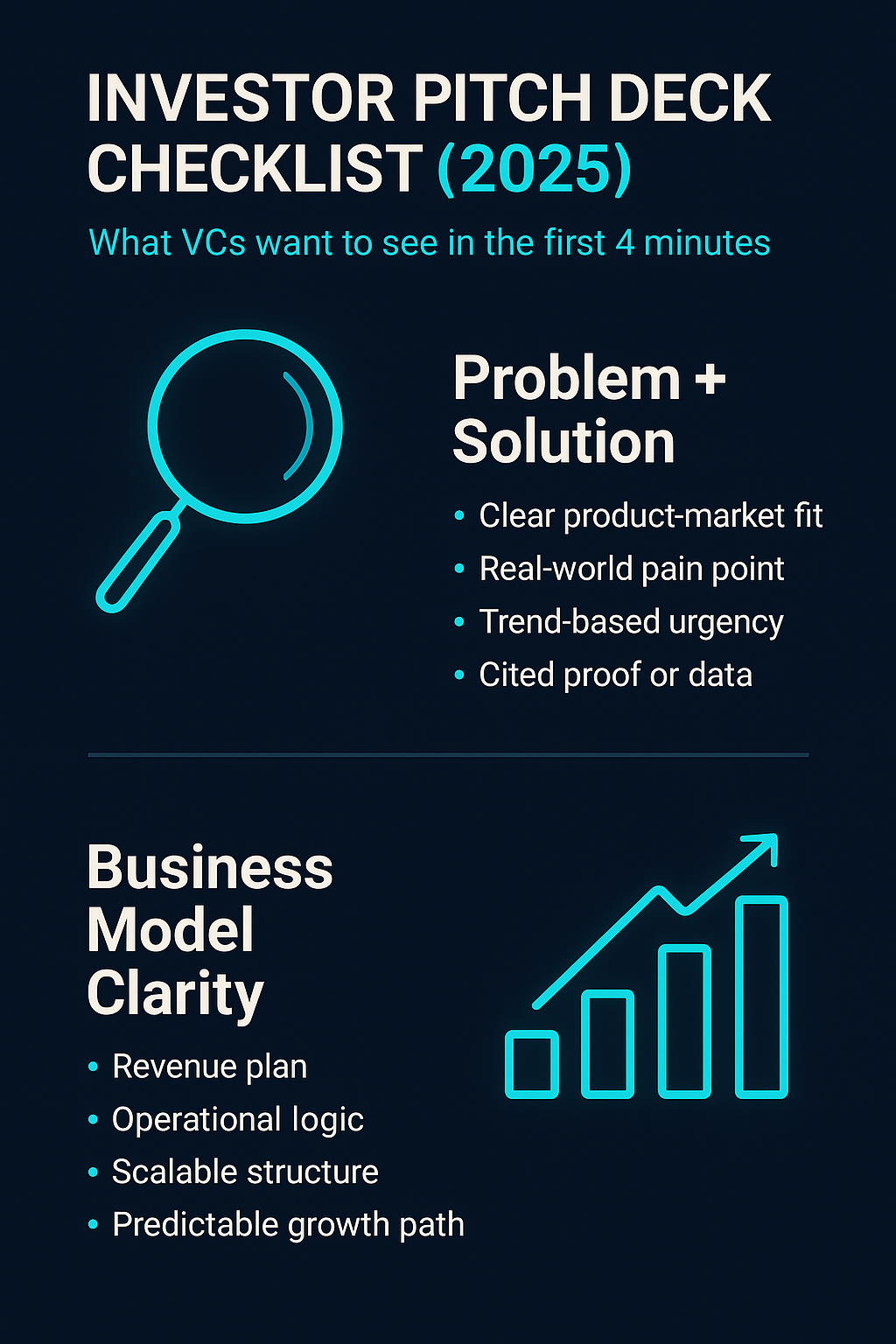
Top 5 Mistakes Startups Make in Pitch Decks (And How to Fix Them)
Even the best ideas can fall flat if your pitch deck misses the mark. Here are the five most common pitch deck mistakes startups make, and simple fixes to help you stand out.
1. Poor design and visual flow
Problem: A poorly designed pitch deck can easily turn investors off and give the impression of unprofessionalism. You need to keep things as clear as possible and have a logical structure.
Solution: Use a professional, streamlined template (you can find lots of these online and credit their designers in your presentation), and a consistent colour and font scheme. Avoid overly complex graphics or animated images.
2. Overcrowded information
Problem: There’s only so much you can fit on one slide! Having too many visuals, text, and data will make it difficult for you to clearly communicate your main points.
Solution: Keep things as concise as possible and only use bullet points on your slides. You can even replace chunks of text with attention-grabbing visuals or charts that can communicate the same message.
3. Unclear problem statement
Problem: Why do we need your product or service? Being unclear about the problem you seek to solve will make your potential investors unsure of whether the market needs your startup in the first place.
Solution: One of the most important sections of your pitch deck will be your problem-solution slide. It should clearly describe the issues that your target market faces in their day-to-day lives and how you plan on solving these with your business.
4. Weak business model
Problem: Being unable to explain how your startup is going to make a profit will leave investors unconfident about the financial viability of your business.
Solution: You need to clearly outline how you plan on generating revenue, and include as much information as possible about your competitive pricing strategy, sales, and customer acquisition tactics.
5. Lack of preparation
Problem: Looking unprepared and having a lacklustre presentation will make it difficult to convince investors to trust in your startup’s credibility and the abilities of your team.
Solution: Your team should go through your entire presentation multiple times, and if possible, gather feedback from others too.
What Your Pitch Deck Should Look Like at Each Startup Funding Stage
When progressing through each funding stage, your startup will need to adapt your pitch deck accordingly. Here’s what your pitch deck should look like at each funding stage:
Pre-seed funding
Pre-seed funding is the earliest stage of development for your startup. You have an idea developed, but you’re seeking initial funding to make it happen.
Must-haves:
- A clear problem-solution section that demonstrates the gap in the market that you intend to fill.
- The overall long-term vision of your startup and your planned goals.
- An introduction to your founding team and why your team is the best people to build your startup.
- Your projected financial metrics will demonstrate your growth potential.
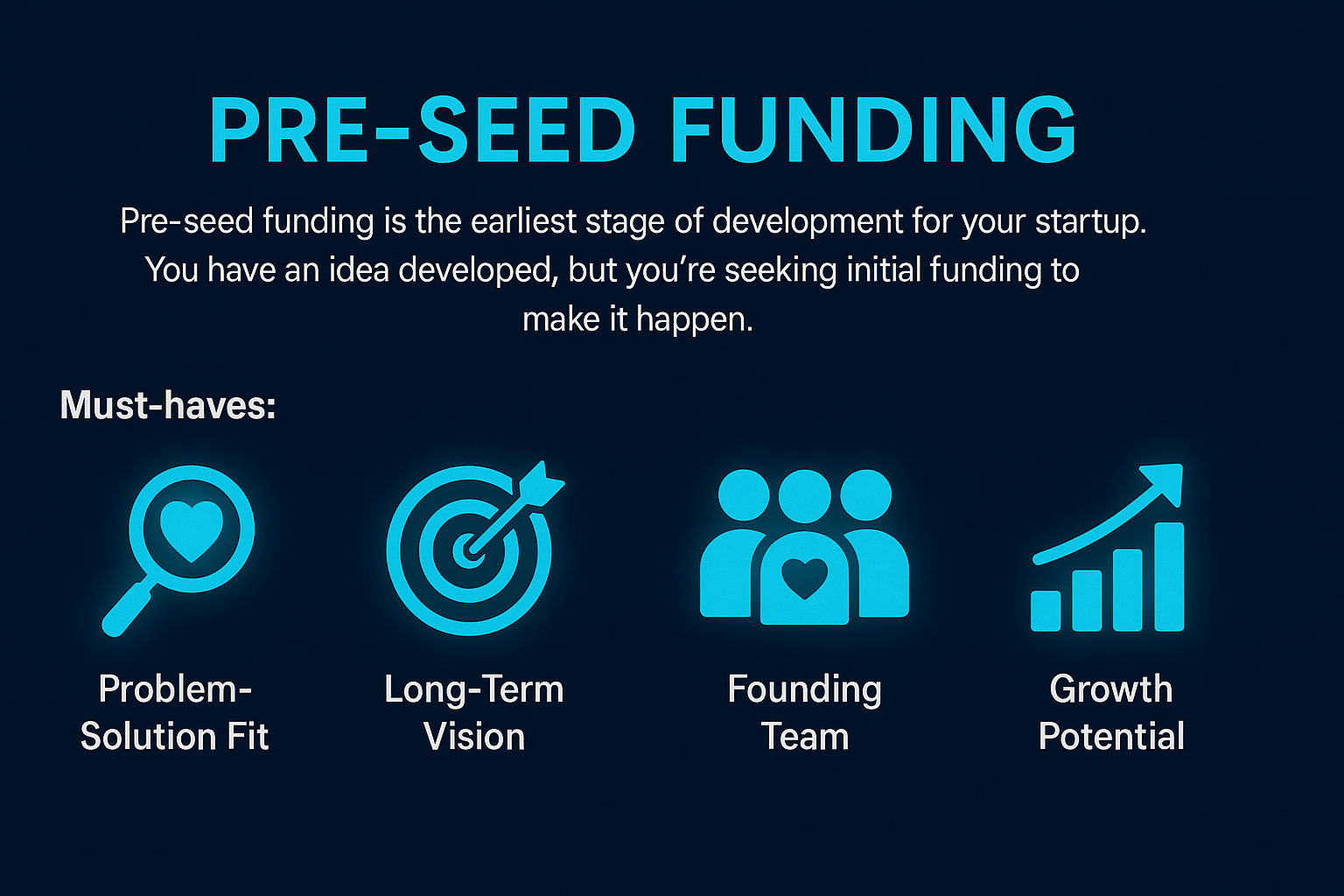
Seed funding
After you’ve secured your initial funding, you move on to the seed funding stage. At this point, you’ll be looking for people who can give you larger investments, such as angel investors and venture capitalists. If they can see the potential in your startup, they can help support your business as you gain further traction.
Must-haves:
- All of your pre-seed slides.
- A demonstration of your product and service to see how it will work for potential customers.
- Your planned marketing strategy and customer acquisition strategy.
- Indicate your knowledge of the surrounding competition and identify what makes your product or service stand out.
- A more in-depth business model about the day-to-day operations of your startup.
- Proof of your startup’s early traction by using KPIs and statistics to back up your claims.
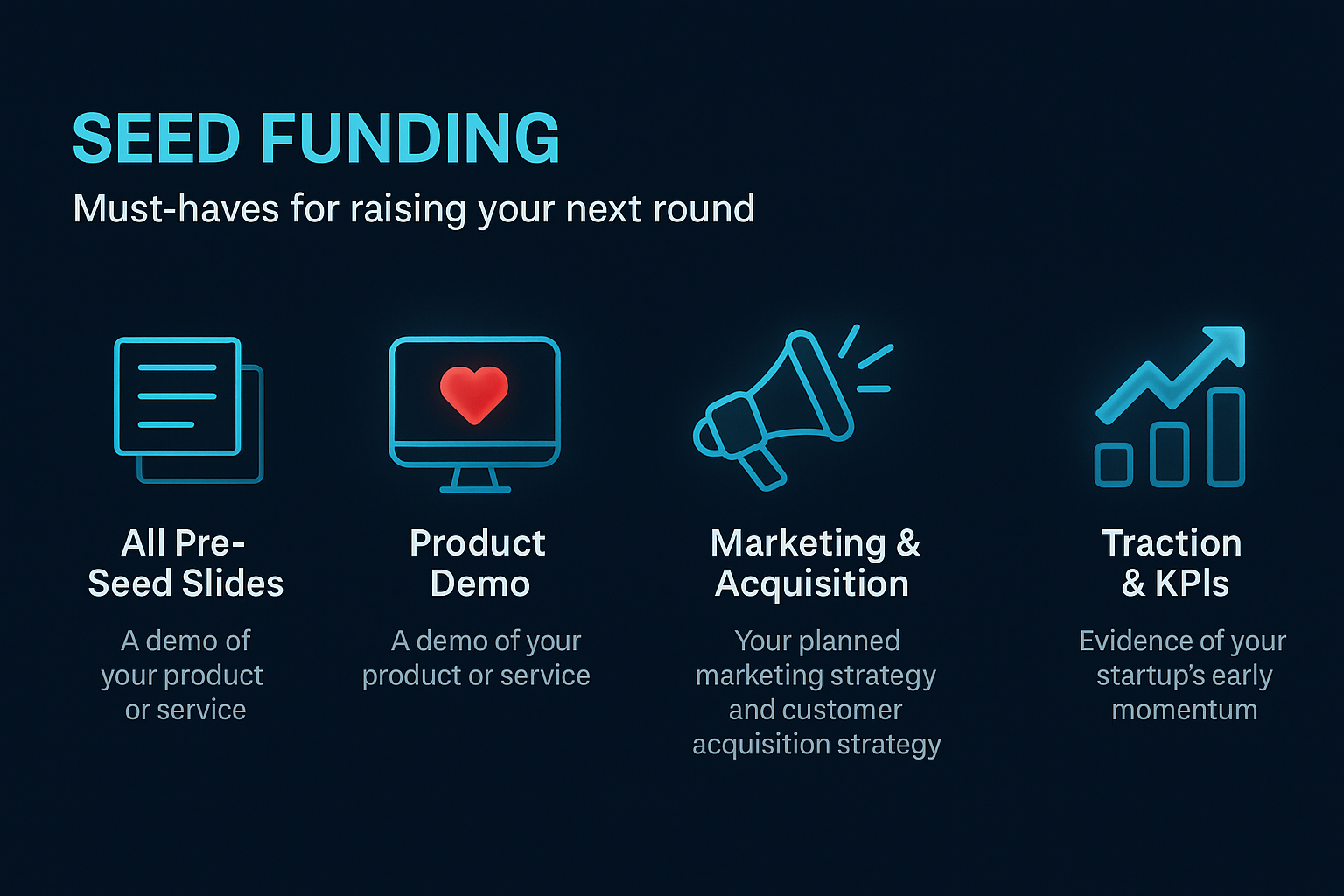
Series A funding
At this stage, you will have started gaining early success and are looking to find more financial backers. You would exchange the financial support of venture capitalists and angel investors for shares within your company.
Must-haves:
- All of your seed slides.
- Validation of your startup’s success from the market by proving how your startup has the ability to continue generating income.
- Optimisation or the improvement of your product or service based on its current performance in the market.
- A scalable marketing plan that you can adapt for different channels and customer bases.
- The growth of your company through new hires for your team.
- Information on how you’ve offset any financial shortfalls you’ve encountered up until this point.
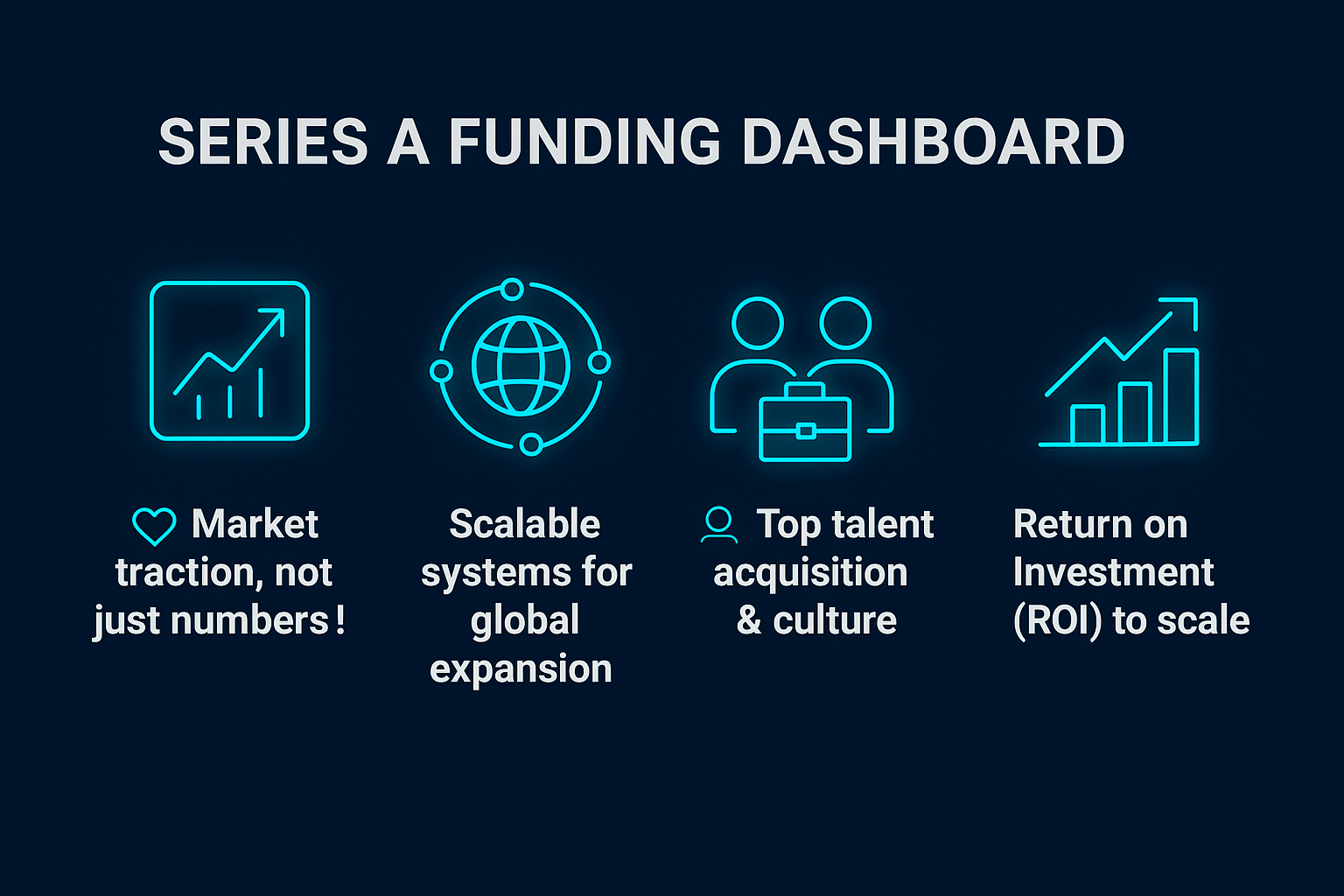
Series B funding
When your startup has achieved Series B funding, you will already have a steady stream of revenue, which generates a dedicated base of customers. Now, you’ll need to polish your pitch deck further to attract even more investors.
Must-haves:
- All of your Series A slides.
- Potential expansion of your business, such as by establishing new operational teams.
- Information on any strategic partnerships you have already built so far.
- Highlights of your achievements and success so far.
Series C & D funding
Once you’ve reached Series C and D funding, your startup is preparing to become a major player in your chosen market. Your growth will be at its most rapid at this point. You can afford to look at expanding globally and exploring new markets. Investors will be much easier to attract at this point, now that your success is fully evident.
Must-haves:
- A polished and streamlined version of your Series B slides.
- Any plans you have for global expansion or your emergence into new markets.
- Explanation of how any new investments will be used to achieve projected milestones.
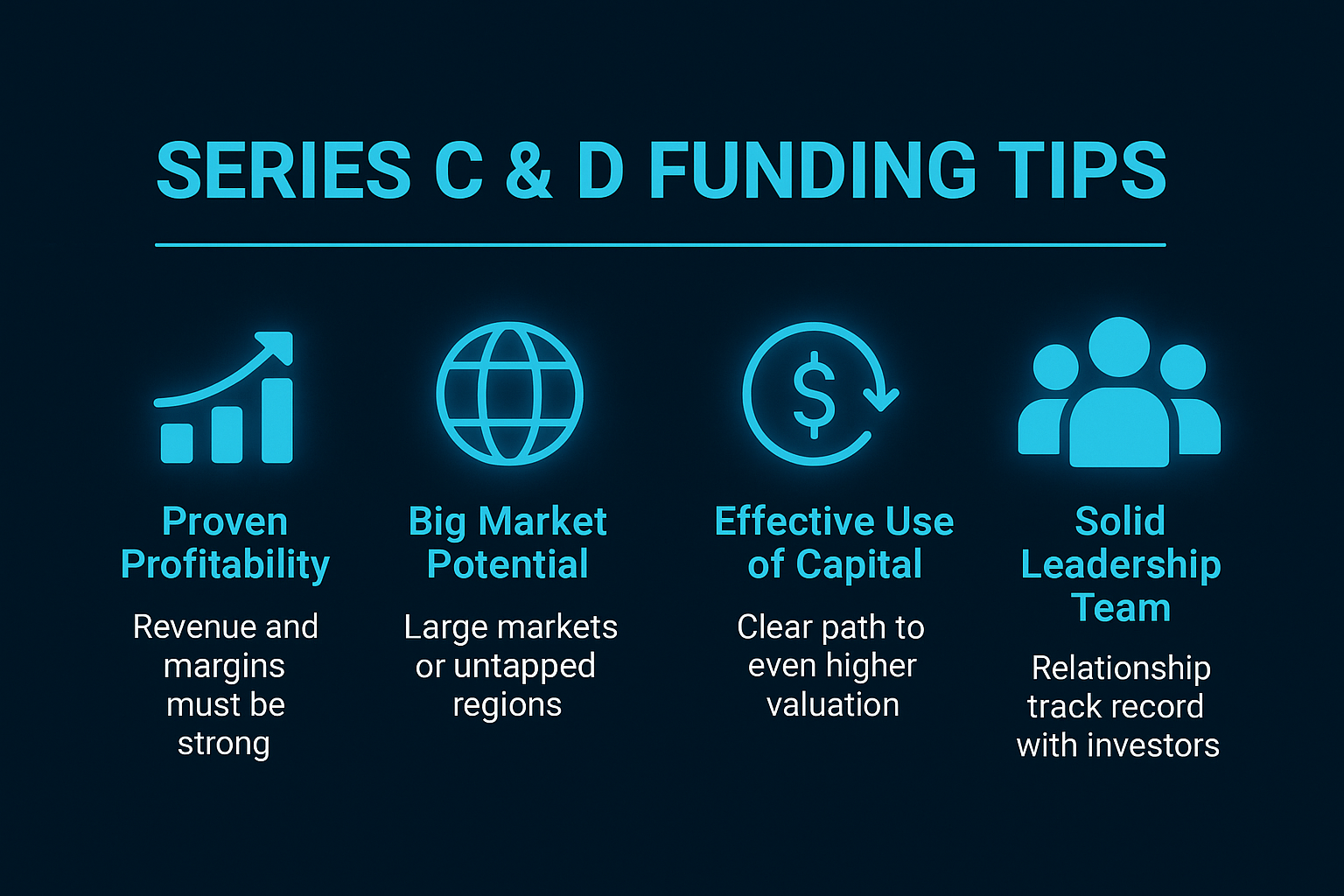
Initial public offering
This is the point that every business hopes for. In this final stage of development, companies are able to offer their shares to the public; this is known as the initial public offering. These shares can be traded on the stock exchange, and your business will be transformed from private to public.
Must-haves:
- An updated version of your Series D slides.
- Potential exit strategies for any investors who want to relinquish their positions.
- Details on your relationship with your chosen investment bank.
Conclusion
Thinking about how your startup is going to survive its various stages of development can be daunting. However, with the help of a successful business plan and effective pitch deck, you can guarantee the upward traction of your startup. If you have a fully in-depth, comprehensive business plan, it’ll help clarify the next steps your startup needs to take before you even start pitching. A concisely informative yet engaging pitch deck at every stage of funding will help keep your investors interested.
It’ll definitely be a long journey for your startup, but a worthwhile one when you have the right tools for the job!
Frequently Asked Questions
1. What’s the ideal length of a pitch deck in 2025?
You should be aiming for around 10-15 slides. Your pitch deck needs to be as concise as possible, so bullet points will be sufficient. There’s a reason why this old adage is still relevant: ‘A picture can often be worth a thousand words’!
2. Can I use the same pitch deck for grants and investors?
No, though different parts of your pitch deck can apply to both grants and investors. You’ll need to tailor for delivering your pitch to deliver to different audiences. Grant committees want to specifically see how your startup aligns with grant goals. On the other hand, investors are more focused on the return on investment (ROI).
3. Do investors still read full business plans?
Yes, when it comes to looking for specific sections, they’re interested in! Investors may not be reading your entire business plan in your initial funding stages, but it is your due diligence to include as much information as possible. If any questions arise at any point, it’ll be easy for your investors to find the answer in your full plan.
4. How often should I update my pitch deck?
Your pitch deck should be updated regularly (either monthly or quarterly) when any changes occur to aspects of your startup. It should also be updated and revised between each funding stage.

